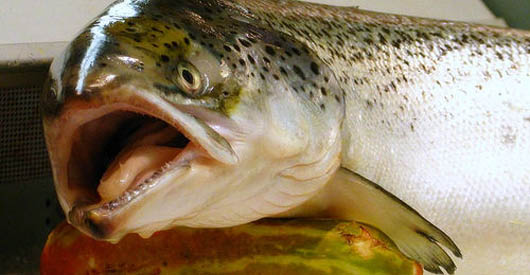Farm-raised salmon practices are often criticized by environmentalists because of pollution risks and stock escaping into the wild, but aquaculture may be needed to meet the demand for fish consumption in times of dwindling wild supplies. Recently, CNN health expert Dr. Melina Jampolis rekindled the debate on whether farm-raised salmon is safe for human consumption. Citing a 2003 Environmental Working Group (EWG) study finding high levels of PCBs in farm-raised fish, Jampolis initially recommended people eat aqua farmed fish only once a week, then she flip-flopped on the issue.

PCBs have been largely banned in the United States since 1977, yet they remain present in our environment as persistent organic pollutants. According to Eco Child’s Play:
The largest contaminated sites in the US include the Hudson River and the Great Lakes; however, PCBs have been detected throughout the world, even the Arctic Circle.
The harmful effects of PCBs on humans has been known for a long time, and accumulation has been found in human tissues, such as the placenta and uterus, as well as breastmilk.
Marine life is greatly effected by PCB contamination, and killer whales are being poisoned from eating wild salmon. Testing ten samples of farm-raised salmon bought at grocery stores, EWG found “PCB levels that should give consumers pause…If the fish were wild, the U.S. Environmental Protection Agency would advise people not to eat them more than once a month.”
The American Heart Association (AHA) recommends adults consume fatty fish twice a week in order to get enough omega-3s. Despite the AHA’s advice, Dr. Jampolis told readers:
A 2003 report by the EWG showed that farmed salmon in the U.S. has the highest levels of PCBs, toxic man-made chemicals, so Canadian salmon may be slightly better. I suggest that you limit farmed salmon consumption to once a week at most if you are unable to find fresh, wild salmon. In addition, trim the skin and fat as much as possible and use cooking methods such as grilling and boiling to reduce fat, as this is where the toxics are stored.
Given the “flurry” of response to Dr. Jampolis’ advice, she has revised her original recommendation. Six days later, CNN reports:
Jampolis, citing the more recent research, agreed that the benefits of eating any salmon outweigh the risks, especially with heart disease being the leading cause of death in the United States and the fact that salmon is one of the best sources of heart healthy omega-3 fatty acids.
Why did Dr. Jampolis flip flop her position on the safety of farm-raised fish? Could it be that the National Fisheries Institute Inc., the largest seafood trade organization in the United States, got a hold of CNN? Quoted in the same article with the doctor’s revision, Gavin Gibbons, spokesman for the National Fisheries Institute Inc., stated, “It’s really high time that people have a new perspective on farmed salmon from a nutrition standpoint.” CNN goes on to talk about how farm-raised Atlantic salmon “has more DHA and EPA omega-3 fatty acids than the same weight of wild salmon”, as well as how it takes less energy and is more environmentally friendly than catching wild fish.
Should consumers have to choose nutrition over the risk of pollutants like PCBs? It is not such a clear choice as the aquaculture industry would like one to believe. The case of wild vs. farm-raised salmon also demonstrates the power of industry over the mainstream media.

You must be logged in to post a comment.